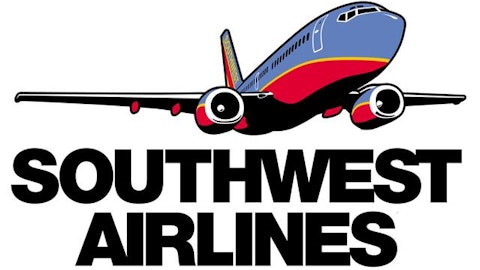Low-cost airlines have been gaining momentum as customers and corporate executives are trying to cut travel expenses. Exploiting that opportunity, JetBlue Airways Corporation (NASDAQ:JBLU), which was founded in 2000, grew at an astonishing pace to establish itself as one of the most successful low-cost airlines in the U.S.

JetBlue Airways Corporation (NASDAQ:JBLU) has strategically chosen route networks that would potentially improve efficiencies. Redeploying aircraft and rolling out services in more profitable geographical markets is likely to support the company’s profitability.
Industry consolidation to help low-cost carriers
The recent rally of JetBlue Airways Corporation (NASDAQ:JBLU) and other U.S. airline carriers was driven by potential benefits that the proposed merger between US Airways Group Inc (NYSE:LCC) and American Airlines would bring to the industry. Though their merger will form the world’s largest carrier, U.S. Airways will remain under pressure until 2017, as American Airlines has net operating losses of $6.6 billion that must be carried forward. Additionally, US Airways Group Inc (NYSE:LCC) estimates that it will incur $1.2 billion in integration and reorganization costs. But, the situation for US Airways could get even worse as long-range planning is difficult in the airline business. Other carriers that have undergone restructuring in the past few years have seen that their projections were entirely different from the reality.
Now, let’s see how the US Airways-American Airlines merger will benefit JetBlue Airways Corporation (NASDAQ:JBLU). The merged company will gain presence in areas where either of them may have had little or no presence. Additionally, they can reduce the number of flights to geographical markets where their combined frequency will be too high.
This brings new opportunities to low-cost airlines like JetBlue Airways Corporation (NASDAQ:JBLU) and Southwest Airlines Co. (NYSE:LUV).
Customer-friendly policies
Industry consolidation would benefit low-cost carriers, so what gives JetBlue Airways Corporation (NASDAQ:JBLU) an edge over others? JetBlue Airways Corporation (NASDAQ:JBLU) and Southwest Airlines Co. (NYSE:LUV) both offer amenities and benefits not available on competitor airlines. However, Southwest Airlines Co. (NYSE:LUV) has failed to capitalize on this differentiation, while JetBlue embraced the opportunity by positioning itself as a “premium service” carrier. In fact, JetBlue has been constantly emphasizing its premium amenities and services in promotional campaigns. On the other hand, Southwest Airlines Co. (NYSE:LUV) is still struggling to differentiate itself from other carriers.
Additionally, JetBlue is now seen as a customer service-oriented carrier, not just a low cost one. For example, almost every airline in the United States charges for checking bags, and even Southwest Airlines Co. (NYSE:LUV) charges if a passenger has more than two bags. But, that service is still free on JetBlue. Another example, JetBlue has no flight change fees, plus free satellite radio and satellite TV at every seat. No other carrier offers all these things. Southwest Airlines Co. (NYSE:LUV) has just the no flight change policy.
Expansion in key geographical markets
As US Airways and American Airlines began to reduce flight frequencies at Boston’s Logan International Airport, JetBlue started increasing its presence there. Now, it has become the most prominent carrier at Logan. Solid presence at Logan is a boon for JetBlue, as Boston has a high proportion of corporate travelers and business fares. As the company expands in Boston, its yield per mile and average ticket price both increased 10% in 2012, compared to the previous year.
Additionally, the company has boosted its presence in Caribbean markets, especially in San Juan, which now account for 27% of total seating capacity. The Caribbean operations are at break-even, and should contribute to income in 2014.
JetBlue plans to double the number of flights at Ft. Lauderdale to 100 per day. Though it will require some investments, it’s another big opportunity. JetBlue’s operations at the Florida hotspot are already income-positive.
March traffic shows solid growth
JetBlue Airways Corporation (NASDAQ:JBLU) reported that its March 2013 traffic increased 8.6% from March 2012, while capacity increased by 7.5%. The carrier’s PRASM (preliminary passenger revenue per available seat mile) increased 7% in March year-over-year, and load factor jumped 0.8% to 87.1%.
Let’s compare that to Southwest, whose traffic rose just 4% in March, while PRASM was stagnant. Southwest reported a capacity growth of just 3.8% compared to JetBlue’s 7.5%. The percentage of seats filled, or load factor, rose to 82% from 81.8%, but that’s still far lower than 87.1% of JetBlue.
Bottom line
JetBlue has certainly been reducing its long-term debt load, while growing the aircraft fleet. If economic growth and fuel environments remain favorable, earnings are highly likely to grow, thanks to improving revenue-per-available-seat-mile and occupancy.
Even a soft economic environment would benefit low-cost carriers like JetBlue because the company would then be able to target corporate travelers who usually fly business class, but have had to cut travel expenses.
The article Is It Time To Get Bullish On JetBlue? originally appeared on Fool.com and is written by Jeremiah Feliciano.
Copyright © 1995 – 2013 The Motley Fool, LLC. All rights reserved. The Motley Fool has a disclosure policy.

